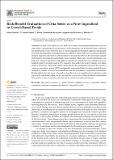Por favor, use este identificador para citar o enlazar a este item:
http://hdl.handle.net/10261/307142COMPARTIR / EXPORTAR:
 SHARE SHARE
 CORE
BASE CORE
BASE
|
|
| Visualizar otros formatos: MARC | Dublin Core | RDF | ORE | MODS | METS | DIDL | DATACITE | |

| Título: | Risk/benefit evaluation of chia seeds as a new ingredient in cereal-based foods |
Autor: | Mesías, Marta CSIC ORCID ; Gómez García, Pablo CSIC ORCID; Olombrada, Elena CSIC ORCID; Holgado, Francisca CSIC ORCID ; Morales, F. J. CSIC ORCID | Palabras clave: | Chia (Salvia hispanica L.) Public health Seeds Biscuits Maillard reaction Safety Acrylamide Risk/benefit Furanic compounds Nutritional properties |
Fecha de publicación: | 2023 | Editor: | Multidisciplinary Digital Publishing Institute | Citación: | International Journal of Environmental Research and Public Health 20(6): 5114 (2023) | Resumen: | Chia seed (Salvia hispanica L.) is a food rich in protein, fiber, polyunsaturated fatty acids and antioxidants. Consequently, its incorporation in food formulations may be desirable from a nutritional and healthy point of view. However, there is concern regarding the formation of process contaminants when they are subjected to thermal processing. The objective of this study was to incorporate different amounts of ground chia seeds in a biscuit model to evaluate the effect on the antioxidant capacity and formation of acrylamide and furfurals. Seven standard “Maria-type” biscuit formulations were prepared, replacing wheat flour with different amounts of ground chia seeds (defatted and non-defatted), from 0% (control biscuit) to 15% (respect to total solids in the recipe). Samples were baked at 180 °C for 22 min. Compared with the control biscuit, chia formulations increased the content of nutrients, antioxidant capacity (ABTS) and phenolic compounds (Folin–Ciocalteau method) but also doubled acrylamide levels and even raised more than 10 times furanic compound concentrations. Results indicate that the use of chia seeds as ingredients in new cereal-based formulations would improve the nutritional profile but also increase the occurrence of chemical process contaminants. This paradox should be carefully considered in the context of risk/benefit analysis. | Descripción: | This article belongs to the Special Issue Processed Food: Nutrition, Safety and Public Health. | Versión del editor: | https://doi.org/10.3390/ijerph20065114 | URI: | http://hdl.handle.net/10261/307142 | DOI: | 10.3390/ijerph20065114 | E-ISSN: | 1660-4601 |
| Aparece en las colecciones: | (ICTAN) Artículos |
Ficheros en este ítem:
| Fichero | Descripción | Tamaño | Formato | |
|---|---|---|---|---|
| riskfood.pdf | 1,55 MB | Adobe PDF |  Visualizar/Abrir |
CORE Recommender
PubMed Central
Citations
3
checked on 13-mar-2024
SCOPUSTM
Citations
3
checked on 01-may-2024
Page view(s)
43
checked on 01-may-2024
Download(s)
83
checked on 01-may-2024



